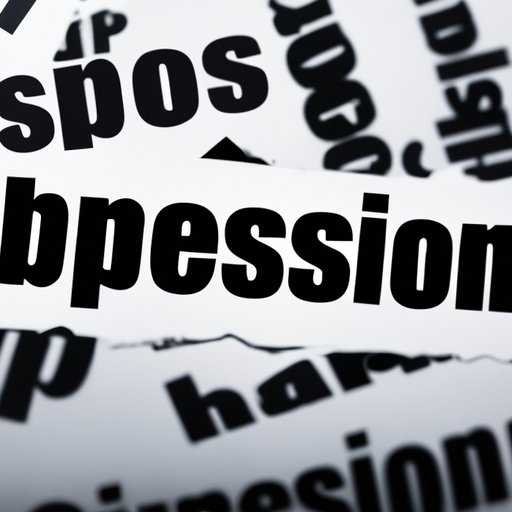
Introduction
Depression is a common mental health disorder that affects individuals of all ages and backgrounds. According to the World Health Organization, over 264 million people worldwide suffer from depression, making it one of the leading causes of disability and chronic illness. While depression is typically associated with feelings of sadness and hopelessness, it can also manifest itself as physical pain.
Many individuals with depression may not recognize the connection between their mental and physical symptoms, leading to an under-reporting of pain and difficulty in seeking treatment. This article aims to break this stigma and explore the correlation between depression and physical pain, including causes and effective treatment options.
Breaking the Stigma: The Correlation Between Depression and Physical Pain
Historically, mental health disorders have been stigmatized and overlooked in society. Many individuals feel shame or embarrassment in discussing their mental health struggles or seeking treatment. This stigma has contributed to low rates of diagnosis and treatment for mental health disorders.
Furthermore, depression is often overlooked as a cause of physical pain. Many individuals with depression may describe physical symptoms such as headaches or back pain without recognizing their underlying mental health condition. This can lead to a delay in seeking proper treatment and management of both mental and physical symptoms.
It is important to break this stigma surrounding mental health disorders. Seeking help for both mental and physical symptoms is crucial in effectively managing and treating pain associated with depression. Encouraging individuals to openly discuss their symptoms and seek professional help can help in breaking down the barriers to proper diagnosis and treatment.
From Mental to Physical: Understanding the Link Between Depression and Pain
Depression is a mental health disorder that can impact an individual’s physical sensations and functions. Physical pain is a common symptom of depression, with studies indicating that nearly 65% of individuals with depression experience physical pain.
Physical pain associated with depression can present in various forms, including headaches, back pain, joint pain, and muscle aches. These symptoms can be chronic in nature and may not respond effectively to conventional pain management techniques.
Depression can alter brain chemistry and the processing of pain, leading to physical symptoms. Chemical imbalances in the brain can enhance sensitivity to pain or decrease one’s pain tolerance, contributing to ongoing physical pain and discomfort.
When Your Mind Hurts Your Body: The Science Behind Depression-Induced Pain
There are several physiological mechanisms that contribute to the link between depression and pain. Studies suggest that inflammation and oxidative stress can have a significant impact on the sensation of pain in individuals with depression. These processes can contribute to nerve damage, muscle inflammation, and joint pain, leading to ongoing physical symptoms.
Depression can also cause specific types of physical pain. For example, individuals with depression may experience gut pain or discomfort due to the link between gut health and mental wellness. Additionally, depression can cause tension headaches or migraines due to stress and muscle tension in the neck and shoulders.
It is important to acknowledge and treat both mental and physical symptoms of depression in order to effectively manage pain. Ignoring physical symptoms can lead to further complications and exacerbation of both mental and physical symptoms.
The Hidden Costs of Depression: How Physical Pain Can Be a Symptom
Physical pain can sometimes be a primary symptom of depression, leading to serious economic and social costs. Untreated depression and physical pain can contribute to reduced productivity, missed opportunities, and decreased quality of life.
Individuals with depression and physical pain may also seek out self-medication or alternative treatment options, leading to increased healthcare costs and potential adverse side-effects. Proper diagnosis and treatment of both mental and physical symptoms can help reduce the overall costs associated with depression and physical pain.
Exploring the Connection: Why Treating Depression Can Help Alleviate Physical Pain
Treating depression can also alleviate physical pain. Effective management of both mental and physical symptoms can lead to improved quality of life and increased productivity.
Cognitive-behavioral therapy and antidepressant medications have been shown to be effective in managing both depression and physical pain symptoms. Exercise, mindfulness, and other alternative therapies can also contribute to improving overall wellness and reducing ongoing physical discomfort.
It is important to seek professional help when experiencing symptoms of depression and physical pain. A healthcare provider can help develop a personalized treatment plan to manage symptoms and enhance overall wellness.
Conclusion
Depression can manifest itself as physical pain, leading to complications and a decreased quality of life. Understanding the correlation between depression and physical pain is crucial in breaking the stigma surrounding mental health disorders and promoting proper diagnosis and treatment of both mental and physical symptoms.
It is important to seek help if you are experiencing both depression and physical pain. Effective management of symptoms can improve overall wellness and enhance quality of life. Encouraging individuals to openly discuss their symptoms and seek professional help is crucial in breaking down the barriers to proper diagnosis and treatment.




